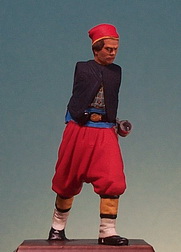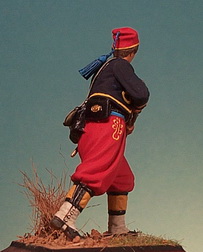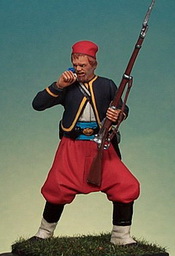HISTORICAL MINIATURES JOURNAL ISSUE NUMBER 10
PUBLISHED
BY GEORGE GRASSE
AMERICAN CIVIL WAR ZOUAVES
RESEARCH NOTES FOR MODELING
54mm SCALE AMERICAN CIVIL WAR ZOUAVES: PART 10
1st BATTALION, LOUISIANA INFANTRY
"COPPENS' ZOUAVES" HISTORY
Several Confederate States had a slight
propensity to authorize the formation of units smaller than the typical
10-company, one-battalion infantry regiment. In most cases, these
formations were formed with three to six companies and specifically called
"battalions". Louisiana especially had a number of these infantry
battalions with varying designations such as the 1st Battalion (Dreux, five
companies), 1st Special Battalion (Wheat, five companies), 1st State Battalion
(Hardee, Stuart, and Kavanaugh, three companies), and, the subject of this
article, the 1st Zouave Battalion (Coppens, six companies). There were more
battalions, some numbered and others known by name only, usually its commander.
The 1st Zouave Battalion was organized at Camp
Walker near New Orleans in March of 1861 and moved to Pensacola,
Florida, on 2 April 1861 originally with 616 men of all ranks. During its
stay in Pensacola, which lasted until August of the same year, Company E was
permanently detached to be reformed as a company in the 12th Louisiana Heavy
Artillery Battalion. The rest of the battalion moved east to Richmond,
Virginia, sometime in early 1862..
During this period, part of
the garrison of Fort Magruder on the Peninsula which was abandoned on
McClellan's advance, companies B and C of the 7th Louisiana Infantry Regiment
were added to the battalion becoming a new E company and two new companies, G
and H; this gave the battalion an eight-company strength. The 1st Zouave
Battalion was also known at this time as the Louisiana Zouaves and Chasseurs
Regiment. For the Seven Days' Battles, May and June 1862, it was assigned
to Pryor's Fifth Brigade, Longstreet's Division, and listed as the 1st Louisiana
Battalion. The brigade also included the 14th Alabama Infantry Regiment,
3rd Virginia Infantry Regiment, and Captain Victor Maurin's "Donaldsonville"
Louisiana Battery. Casualties were quite heavy during these battles.
It went into action with 225 all ranks of which nearly 150 were casualties.
In July 1862, Coppen's Louisiana
Battalion, as it was called during this period, must have recovered enough
wounded, sick, and even replacements to remain a cohesive unit. It was
re-assigned to the all-Louisiana brigade (nickname 2nd Louisiana Brigade) of
General Starke which consisted of the 1st, 2nd, 9th, 10th, and 15th Louisiana
Infantry Regiments, collectively also known as the Fourth Brigade of General
"Stonewall" Jackson's First Division commanded by General Taliaferro of
"Stonewall" Jackson's Corps (or Left Wing) of the Army of Northern Virginia.
The battles and campaigns of Second Bull Run, Antietam, and Fredericksburg
further depleted the unit especially the Battle of Antietam where its founder,
Lt.-Colonel George A. G. de Coppens was killed in action probably along the
Hagerstown Pike. Command was assumed by Marie A. de Coppens of Company F,
promoted to Lt.-Colonel that same day.
The Zouaves, who by now were
probably clothed mostly in Confederate gray, were held in reserve during the
Fredericksburg battle but shortly after, in January, it was transferred to the
Department of Virginia and North Carolina where it served out the war performing
guard duty, the collection of conscripts, and the capture of deserters. It
had a strength on duty of 18 officers (!) and 41 men in February 1864. By
September 1864, its strength was reported as 9 officers (!) and 32 men. By
December 1864, the unit disappears from military records. Although there
were a few minor scuffles while in Virginia and North Carolina, the unit ended
the war with 52 men killed in action, 26 died of disease, and 2 died from
accidents, for a total of 80 war dead. There is no known record of the
captured, wounded, or those disabled by disease or accidents.
Chronological Summary of
Service for the 1st Battalion Louisiana Infantry (Coppen's)
|
From / To |
Brigade |
Division |
Corps |
Army |
|
Apr 1861 - Aug 1861 |
n/a |
n/a |
n/a |
Defenses of
Pensacola |
|
Sep 1861 - May 1862 |
n/a |
n/a |
n/a |
Fort
Magruder, Peninsula |
|
May 1862 - Jul 1862 |
Pryor's (Fifth) |
Longstreet |
Magruder's Command |
Army of
Northern Virginia |
|
Jul 1862 - Jan 1863 |
Starke (Fourth) |
Taliaferro |
Jackson's Corps |
Army of
Northern Virginia |
|
Jan 1863 - Dec 1864? |
unknown |
unknown |
unknown |
SE
Virginia/North Carolina |
THE UNIFORM
There are two uniform sources for Coppens' Zouaves: 1)
Units of the Confederate States Army by Joseph H. Crute, Jr., page
139 (but this is a written summary giving just the basics); and, 2) Don Troiani's
Regiments & Uniforms of the Civil War, Art by Don
Troiani, text by Earl J. Coates et al (see bibliography). This latter
reference is by far, the best available full-color representation of what the
Coppens' Zouaves looked like, at least initially in 1861 and into 1862.
The Spring and Summer campaigns of 1862 probably wore out most articles of
clothing and the extent to which Coppens could furnish Zouave clothing is not
known. Probably, however, clothing items were replaced with "regular"
Confederate items so the unit presented a motley mixture of worn-out Zouave and
regular Confederate infantry garb.
There are, however, several details of the uniform that
are largely unknown: 1) Troiani's rendering cleverly poses the subject so that
the front of the jacket is not visible. The jacket may have had trefoils
(as I chose to show on this figure) or the jacket front was not adorned; 2) the
fez had yellow piping at the base (as I chose) or it did not, i.e., the fez was
solid red with no piping; 3) the trousers had yellow "Hungarian
hussar-style" knots at the thighs (as I did) or the trousers were plain red; 4)
gaiters are somewhat problematical a) plain white leggings without "jambons", or
b) black-trimmed "ochre" or plain black jambons.
I decided to model the Troiani figure which includes a
number of interesting Zouave details. The expected soft red fez with
yellow trim is adorned with a blue tassel. The jacket is trimmed entirely
in yellow including trefoils. Yellow-piped
pointed cuffs. The baggy trousers are red and show fine yellow Hungarian hussar-style piping on the upper thighs. The mid-blue waist sash does not
appear to have a tail probably so as not to hide the trouser piping or because
it was a dangling nuisance. The
shirt under the jacket was most likely homespun.
Making A PRIVATE FROM THE 1st ZOUAVE BATTALION LOUISIANA
INFANTRY "COPPENS' ZOUAVES"
| Figure 1
 |
One figure will be constructed using one of the standard
poses from Shenandoah's 5th New York Zouave kits, in this case from the
"advancing" range SHZ001 to SHZ005. I modified the kit
components by adding a pair of arms for a figure firing the musket.
It will be altered slightly so the figure is actually carrying the
musket to the shoulder at a low angle as if to bring the weapon up
to fire at a moments notice. I added a tin cup. I
removed the raised "US" detail on the belt buckle and cartridge box and replaced
them with Shenandoah PE "CS" details.
The kit parts have already been cleaned of
seam lines and polished using a
Dremel tool with a #428 wire brush. Note that waist sash
"tail" that is normally hanging just in front of the haversack has
been cut off and the area polished. It appears that the
waistband was worn but wrapped completely around the waist.
For priming, either Tamiya
or Model Master spray primers will do the job well enough.
After priming, the head will be glued into
position looking to the left. The figure will then be mounted
on its wood base ready for painting.
|
| Figure 2 shows the primed figure on its
finished base (Andrea ANP017) with the face painted according to steps
outlined in HM Journal
Issue 8 (76th Pennsylvania
"Keystone Zouaves") and
Issue 9
(114th Pennsylvania "Collis' Zouaves). All
painting is done using Andrea and/or Vallejo acrylic paints. I
often mix them together interchangeably to get the shade I want.
Often, I use some of the brilliant Vallejo shades to "liven up" the
Andrea colors and vice-versa to tone the Vallejo colors down.
Note that the fez has been over-painted in the flesh color and
serves as an excellent base for applying the finished red fez color.
A few modifications mentioned above seen here
are 1) the brass PE belt buckle, 2) the addition of the tin cup, and
3) removal of the waist sash tail that would normally be visible
just in front of the haversack hanging down the left front thigh.
The shirt and the white portion of the gaiters
have a coat of "off white" as a preliminary base coat. Before
continuing with the figure, I am now going to discuss the other
kit's details below. |
Figure 2

|
Figure 3
|
 |
Figure 4 shows the "inside" details
painted. In general, after the face is painted, I next start
on the inside details and work out. That is, in this example,
the homespun shirt, waist sash and black leather waist belt.
The first coat of paint for the gaiters is also applied. The
white portion is regular white right out of the bottle and then
"stained" with my mix of "off white" (Vallejo white plus Vallejo
khaki). The "yellow" is Vallejo sand yellow mixed with a
little "off white" then stained with sand yellow and and Andrea
wood. white plus of the uniform
painted. The trefoil "loop holes" are painted the color of the
jacket which shows through the lace. In some regiments,
the "loop holes" were filled in with lace or had a button sewn in
place. This
figure represents a private soldier in fresh, original issue
uniform, say in mid-to-late 1861. By the time Coppens' Zouaves
arrived in Richmond in the Spring of 1862, many of the original
clothing items needed replacement. Whether for lack of funds
or uniform availability, these Zouaves started to accumulate
standard and/or non-standard Confederate garb. Certainly after
the rigors of the Peninsular Campaign, not much of the original
uniform remained. |
|
Figure 4

|
Figure 5 shows completion of the
leggings and shoes and the addition of the base coat for the jacket
and baggy trousers. My "uniform blue" is a mix of 4
parts Prussian Blue, 1 part Flat Black, and 1 part Violet. I
use Andrea and Vallejo interchangeably although the original Andrea
presented the best "flat" look. The trousers are a mix of
Andrea Red and Napoleonic Red of which I still have some bottles
remaining.
Figure 5 shows the completed
figure. If this were an NCO, rank stripes would have been worn
points-up just above the cuff chevron, two for corporal and three
for sergeant. It would be interesting to complete a Coppen's
Zouave with Zouave-style jacket and Confederate-issue trousers
without gaiters.
|
Figure 5
 |
|
Figure 6

|
Figure 6 shows the completed
figure from the right rear. Note the thigh ornamentation.
Compare Figure 6 (left) with another version painted a couple of
years ago as shown in Figure 7 (right). Note the blank front
of the jacket sans trefoils, no piping on the fez, and black
"jambons"
|
Figure 7
 |
--------------------------------------------------------------------------------------------------------------------------------
BIBLIOGRAPHY
Battles and Leaders of the Civil War,
Volume II. New York: Thomas Yoseloff, 1956 (various 1862 orders of battle to
trace this unit's assignments).
Bergeron, Arthur W. Jr. Guide
to Louisiana Confederate Military Units 1861-1865. Baton Rouge:
Louisiana State University Press, 1989 (see pages 152-154 which includes all of
the commanders of the battalion and individual companies).
Crute, Joseph H. Jr. Units of the
Confederate States Army. Midlothian, Virginia: Derwent Books, 1987 (see
page 139).
Smith, Robin. American Civil War Zouaves,
Osprey Elite #62 illustrated by Bill
Younghusband. Oxford, UK: Osprey Publishing, 1996. (see pages 48-51;
mostly anecdotal information).
Troiani, Don. Don Troiani's
Regiments & Uniforms of the Civil War, Art by Don
Troiani, text by Earl J. Coates, Michael J. McAfee, and Don Troiani.
Mechanicsburg, PA: Stackpole Books, 2002 (see
page 75 for an outstanding Coppens' Zouave Troiani full-color image).
GO TO?
© Copyright by George Grasse






